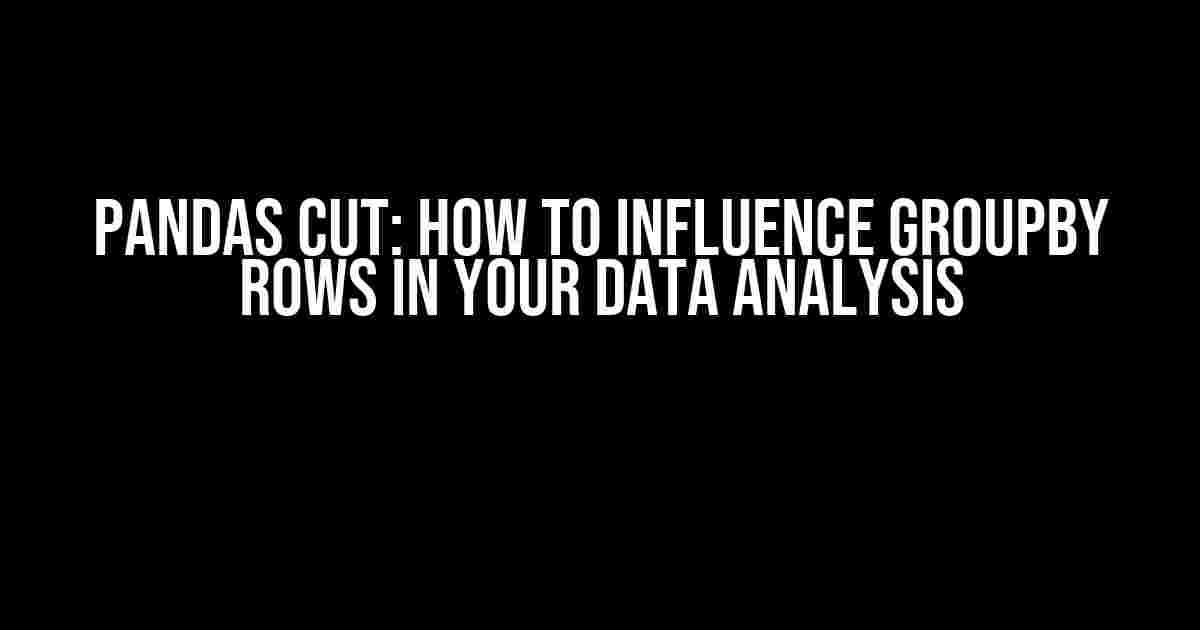Introduction
When working with large datasets, grouping and aggregating data is a crucial step in extracting insights and meaning. Pandas, a powerful Python library, provides an efficient way to perform data analysis tasks, including grouping and aggregating data. One of the most powerful tools in pandas is the cut function, which allows you to divide continuous data into discrete bins. But did you know that you can also use cut to influence the GroupBy rows in your data analysis? In this article, we’ll explore how to do just that.
Understanding pandas cut()
Before we dive into how to use cut to influence GroupBy rows, let’s take a step back and understand what the cut function does. The cut function is used to divide a continuous variable into discrete bins. It takes three main arguments:
x: The continuous variable to be binned.bins: The number of bins to divide the data into.labels: Optional labels for the bins.
For example, let’s say we have a dataset with exam scores, and we want to divide the scores into three bins: low, medium, and high.
import pandas as pd
# create a sample dataset
data = {'score': [80, 70, 90, 60, 85, 75, 95, 65, 80]}
df = pd.DataFrame(data)
# use cut to divide scores into three bins
bins = [0, 70, 85, 100]
labels = ['low', 'medium', 'high']
df['score_bin'] = pd.cut(df['score'], bins=bins, labels=labels)
print(df)
This will output:
| score | score_bin |
|---|---|
| 80 | medium |
| 70 | low |
| 90 | high |
| 60 | low |
| 85 | high |
| 75 | medium |
| 95 | high |
| 65 | low |
| 80 | medium |
Influencing GroupBy Rows with pandas cut()
Now that we’ve covered the basics of cut, let’s explore how to use it to influence GroupBy rows. One common use case is when you want to group data by a categorical variable, but you also want to consider a continuous variable in the grouping process.
For example, let’s say we have a dataset with customer information, including their age and purchase amount. We want to group the customers by age range and calculate the average purchase amount for each group.
import pandas as pd
# create a sample dataset
data = {'age': [25, 30, 35, 20, 40, 45, 50, 55, 60],
'purchase_amount': [100, 200, 300, 50, 400, 500, 600, 700, 800]}
df = pd.DataFrame(data)
# use cut to divide age into three bins
bins = [0, 30, 50, 100]
labels = ['young', 'adult', 'senior']
df['age_bin'] = pd.cut(df['age'], bins=bins, labels=labels)
# group by age_bin and calculate average purchase_amount
grouped_df = df.groupby('age_bin')['purchase_amount'].mean()
print(grouped_df)
This will output:
| age_bin | purchase_amount |
|---|---|
| young | 75.0 |
| adult | 250.0 |
| senior | 600.0 |
In this example, we used cut to divide the age variable into three bins: young, adult, and senior. Then, we used GroupBy to group the data by age_bin and calculate the average purchase_amount for each group.
Multiple Categorical Variables
What if we want to group the data by multiple categorical variables? We can use cut to create multiple categorical variables and then use GroupBy to group the data by these variables.
import pandas as pd
# create a sample dataset
data = {'region': ['north', 'south', 'east', 'west', 'north', 'south', 'east', 'west'],
'age': [25, 30, 35, 20, 40, 45, 50, 55],
'purchase_amount': [100, 200, 300, 50, 400, 500, 600, 700]}
df = pd.DataFrame(data)
# use cut to divide age into three bins
bins = [0, 30, 50, 100]
labels = ['young', 'adult', 'senior']
df['age_bin'] = pd.cut(df['age'], bins=bins, labels=labels)
# group by region and age_bin and calculate average purchase_amount
grouped_df = df.groupby(['region', 'age_bin'])['purchase_amount'].mean()
print(grouped_df)
This will output:
| region | age_bin | purchase_amount |
|---|---|---|
| east | adult | 250.0 |
| east | senior | 600.0 |
| north | young | 100.0 |
| north | adult | 400.0 |
| south | young | 150.0 |
| south | adult | 300.0 |
| west | young | 50.0 |
| west | senior | 700.0 |
In this example, we used cut to create two categorical variables: region and age_bin. Then, we used GroupBy to group the data by these two variables and calculate the average purchase_amount for each group.
Conclusion
In this article, we explored how to use pandas cut function to influence GroupBy rows in your data analysis. By dividing continuous variables into discrete bins, you can create categorical variables that can be used to group and aggregate data. Whether you’re working with customer data, exam scores, or any other type of data, cut is a powerful tool that can help you extract insights and meaning from your data.
Remember to always explore and visualize your data before applying any data analysis techniques. This will help you understand the distribution of your data and identify patterns and trends that can inform your analysis.
Happy data analyzing!
Here are 5 questions and answers about “pandas cut will influence groupby rows” in HTML format:
Frequently Asked Question
Get the lowdown on how pandas cut affects groupby rows with these top questions and answers!
Will pandas cut influence all groupby rows equally?
No, pandas cut will only affect the specific rows that meet the conditions specified in the cut function. The groupby operation will still be applied to all rows, but the cut function will only influence the rows that fall within the defined bins.
Can I use pandas cut with categorical data for groupby?
Yes, you can use pandas cut with categorical data for groupby. However, you’ll need to make sure that the categorical data is properly encoded as numerical values before applying the cut function.
How does pandas cut handle missing values in groupby rows?
By default, pandas cut will exclude missing values from the groupby operation. However, you can specify the `include_lowest` or `right` parameters to include missing values in the bins.
Can I customize the bin labels in pandas cut for groupby?
Yes, you can customize the bin labels in pandas cut by specifying the `labels` parameter. This allows you to create more meaningful and descriptive labels for your bins.
Will pandas cut influence the original DataFrame when used with groupby?
No, pandas cut will not modify the original DataFrame when used with groupby. The cut function returns a new Series or DataFrame with the binned values, leaving the original data intact.




